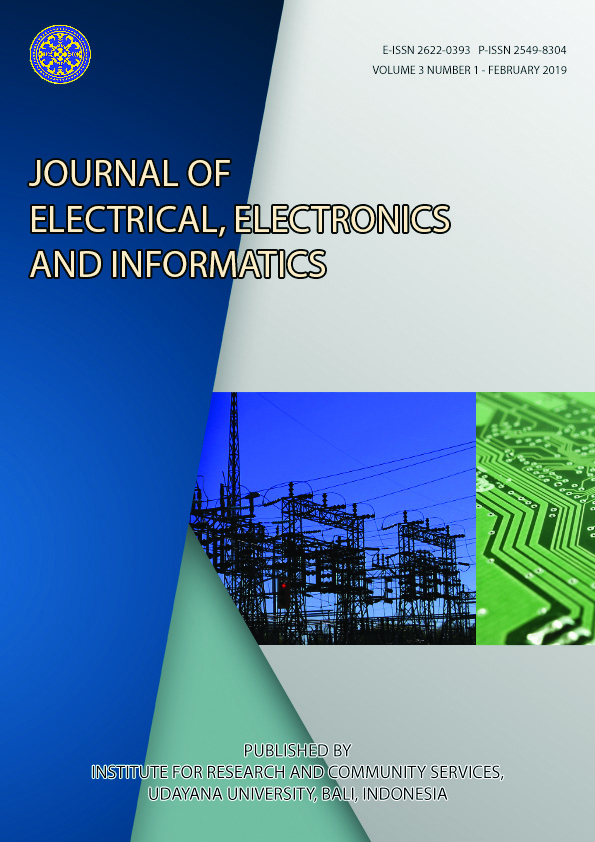Clock Skew Based Computer Identification on Different Types of Area Networks
Abstract
The increase of client devices along with the growth of internet access currently affects to security threats at the user's identity. Identifiers that commonly used today, such as SSID, IP address, MAC address, cookies, and session IDs have a weakness, which is easy to duplicate. Computer identification based on clock skew is an identification method that is not easily duplicated because it is based on the hardware characteristics of the device. Clock skew is the deviation of the clock to the true time which causes each clock to run at a slightly different speed. This study aims to determine the effect of network types to the clock skew stability as a reliable device identification method. This research was conducted on five client computers which running windows and linux operating systems. The measurement was conducted based on three different types of area networks, i.e., LAN, MAN, and WAN. The skew estimation was done using two linear methods i.e., linear programming and linear regression. The measurement results show that the most stable clock skew is found on the LAN measurement because it meets the threshold tolerance limit i.e., ±1 ppm. Skew estimation using linear programming method has better accuracy than linear regression method.
Downloads
References
[2] K. O. Saputra, W. C. Teng, and T. Nara “Hough transform-based clock skew measurement by dynamically locating the region of offset majority,” IEICE TRANSACTIONS on Information and Systems. 2016, pp. 2100-2108.
[3] D. J. Huang, K. T. Yang, C. C. Ni, W. C Teng, T. R Hsiang, and Y. J. Lee, “Clock skew based client device identification in cloud environment,” 26th IEEE International Conference on Advanced Networking and Applications, 2012, pp. 526-533.
[4] T. Kohno, A. Broido, and K. C. Claffy, “Remote physical device fingerprinting,” IEEE Transactions on Dependable and Secure Computing, vol. 2, no. 2, April-June 2005, pp. 93–108.
[5] I.E. Bagci, and U. Roedig. “Node identification using clock skew,” Proceedings of the 5th Workshop on Real-World Wireless Sensor Network, Berlin : Springer Verlag, 2013, pp. 111-123
[6] F. Lanze, A. Panchenko, B. Braatz, and A. Zinnen, “Clock skew based remote device fingerprinting demystified,” Globecom 2012 – Communication and Information System Security Symposium, 2012, pp. 813-819.
[7] D. J. Huang, W. C. Teng, C. Y. Wang, H. Y. Huang, and J. M. Hellerstein, “Clock skew based node identification in wireless sensor networks,” IEEE Global Communications Conference, 2008, pp. 1877–1881.
[8] L. Polčák and B. Franková, “On reliability of clock-skew-based remote computer identification,” 11th International Conference of Security and Cryptography (SECRYPT), 2014, pp. 2291-2298
[9] L. Polčák and B. Franková, “Clock-skew-based computer identification: traps and pitfalls,” Journal of Universal Computer Science, vol. 21 no. 9, 2015, pp. 1210-1233.
[10] D. J. Huang, K. T. Yang, W. C. Teng, and G. M. Chiu, “Design of client device identification by clock skew in clouds,” IEEE International Conference on Automation Science and Engineering (CASE), Taipei, Taiwan, 2014, pp. 1133-1138.
[11] B. Martin, M. Tummala, , J. McEachen, “Multi-homed device detection using clock skew,” Proceedings of The 11th International Conference on Signal Processing and Communication Systems (ICSPCS). Australia: IEEE, 2017.
[12] L. Gomes and J. M. Fernandes, Behavioral Modeling for Embedded Systems and Technologies: Applications for Design and Implementation, New York : Information Science Reference, 2010.
[13] S. Moon, P. Skelly, and D. Towsley, “Estimation and removal of clock skew from network delay measurements,” in 18th Annual Joint Conference of the IEEE Computer and Communications Societies, vol. 1, March 1999, pp. 227–234.
[14] S. Jana and S. K. Kasera. “On fast and accurate detection of unauthorized wireless access points using clock skews”, Proceedings of the 14th ACM International Conference on Mobile Computing and Networking, 2008, pp. 104-115.
[15] M. Cristea and B. Groza, “Fingerprinting smartphones remotely via ICMP timestamps,” IEEE Commucations Letter, vol. 17, no. 6, 2013, pp. 1081-1083
[16] X. Mei, D. Liu, K. Sun, and D. Xu “On feasibility of fingerprinting wireless sensor nodes using physical properties,” 2013 IEEE 27th International Symposium on Parallel & Distributed Processing, 2013, pp. 1112-1121.

This work is licensed under a Creative Commons Attribution-ShareAlike 4.0 International License.











